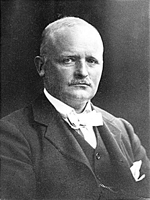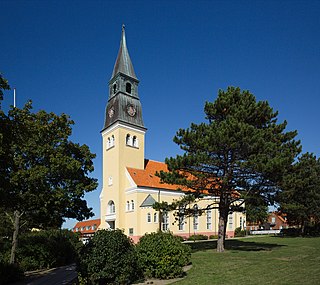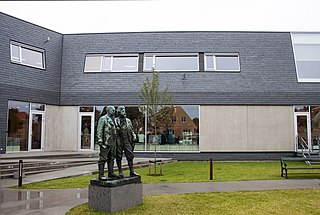
Margrethe II is a member of the Danish royal family who reigned as Queen of Denmark from 14 January 1972 until her abdication on 14 January 2024. Having reigned for exactly 52 years, she was the second-longest reigning Danish monarch after Christian IV.

Skagen is Denmark's northernmost town, on the east coast of the Skagen Odde peninsula in the far north of Jutland, part of Frederikshavn Municipality in Nordjylland, 41 kilometres (25 mi) north of Frederikshavn and 108 kilometres (67 mi) northeast of Aalborg. The Port of Skagen is Denmark's main fishing port and it also has a thriving tourist industry, attracting 2 million people annually.

Frederik IX was King of Denmark from 1947 to 1972.

Princess Benedikte of Denmark, Princess of Sayn-Wittgenstein-Berleburg is a member of the Danish royal family. She is the second daughter and child of King Frederik IX and Queen Ingrid of Denmark. She is the younger sister of Queen Margrethe II of Denmark, and therefore the aunt of Margrethe's son, the current King of Denmark, Frederik X. She is also an older sister of Queen Anne-Marie of Greece.

Alexandrine of Mecklenburg-Schwerin was Queen of Denmark from 1912 to 1947, as well as Queen of Iceland from 1918 to 1944 as the spouse of King Christian X.

Knud, Hereditary Prince of Denmark was a member of the Danish royal family, the younger son and child of King Christian X and Queen Alexandrine.

Hack Kampmann was a Danish architect, Royal Inspector of Listed State Buildings in Jutland and professor at the architecture department of the Royal Danish Academy of Fine Arts. Marselisborg Palace in Aarhus, built between 1899 and 1902, is among his best known works.

Marselisborg Palace is a royal residence of the Danish royal family in Aarhus. It has been the summer residence of Queen Margrethe II since 1967.

Skagen railway station is the main railway station serving the town of Skagen in Vendsyssel, Denmark.

The architecture of Denmark has its origins in the Viking Age, richly revealed by archaeological finds. It became firmly established in the Middle Ages when first Romanesque, then Gothic churches and cathedrals sprang up throughout the country. It was during this period that, in a country with little access to stone, brick became the construction material of choice, not just for churches but also for fortifications and castles.

Princess Caroline-Mathilde of Denmark was a daughter of Prince Harald of Denmark and granddaughter of King Frederik VIII of Denmark. As the wife of Knud, Hereditary Prince of Denmark, she became Hereditary Princess of Denmark.

Sorgenfri Palace is a royal residence of the Danish monarch, located in Lyngby-Taarbæk Municipality, on the east side of Lyngby Kongevej, in the northern suburbs of Copenhagen. The surrounding neighbourhood is called Sorgenfri after it. Only the cellar and foundations survive of the first Sorgenfri House, which was built in 1705 to design by François Dieussart. The current house was built in 1756 by Lauritz de Thurah and later adapted and extended by Peter Meyn in the 1790s. Lauritz de Thurah has also designed buildings which flank the driveway closer to the road.

Skagen Church is a church located in the historic town centre of Skagen, Denmark.

Skagens Museum is an art museum in Skagen, Denmark, that exhibits an extensive collection of works by members of the colony of Skagen Painters who lived and worked in the area in the late 19th and early 20th centuries. Important artists include Marie and P. S. Krøyer, Anna and Michael Ancher, Laurits Tuxen, Viggo Johansen, and Holger Drachmann. The museum also hosts special exhibitions. Its facilities include a café in the Garden House, an old building which for a while served as home residence and studio of Anna and Michael Ancher.

Anchers Hus is an art museum and gallery situated in the former residence of the painters Michael and Anna Ancher in Skagen, Denmark. Anchers Hus is located on Markvej in Skagen, Denmark.

Ulrik Adolph Plesner, usually known as Ulrik Plesner was an innovative Danish architect who designed in a National Romantic style at the beginning of the 20th century. He is remembered in particular for his influence on the style of architecture practiced in Skagen in the north of Jutland.

Brøndums Hotel, in the little harbor town of Skagen in the north of Denmark, is remembered for its close associations with the late 19th-century artists colony known as the Skagen Painters. It still operates as a hotel today.

The Danish National Exhibition of 1909 or The National Exhibition in Aarhus 1909 was an industry, crafts and culture exhibition held in Aarhus, Denmark in 1909 from 18 May to 3 October. The exhibition displayed some 1850 individual works by architects, artists, craftsmen and businesses and attracted 650.000 visitors. The project was a large undertaking for the city with long-lasting effects on cultural institutions and short-term economic problems. The exhibition fairgrounds was named The white City based on the architectural expression chosen by the leading architect Anton Rosen.

Hunters of Skagen is a 1898 painting by artist Peder Severin Krøyer. It depicts a hunt on September 21, 1897. The work was sold to ARoS Aarhus Kunstmuseum in 1899 and has belonged to the museum ever since.





















